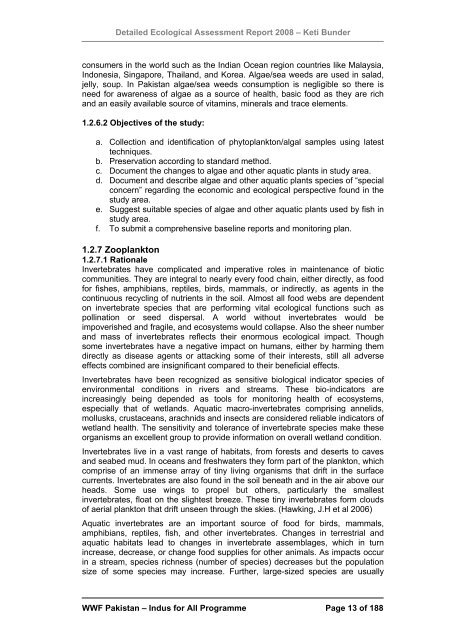Disclaimer note - WWF - Pakistan
Disclaimer note - WWF - Pakistan
Disclaimer note - WWF - Pakistan
You also want an ePaper? Increase the reach of your titles
YUMPU automatically turns print PDFs into web optimized ePapers that Google loves.
Detailed Ecological Assessment Report 2008 – Keti Bunder<br />
consumers in the world such as the Indian Ocean region countries like Malaysia,<br />
Indonesia, Singapore, Thailand, and Korea. Algae/sea weeds are used in salad,<br />
jelly, soup. In <strong>Pakistan</strong> algae/sea weeds consumption is negligible so there is<br />
need for awareness of algae as a source of health, basic food as they are rich<br />
and an easily available source of vitamins, minerals and trace elements.<br />
1.2.6.2 Objectives of the study:<br />
a. Collection and identification of phytoplankton/algal samples using latest<br />
techniques.<br />
b. Preservation according to standard method.<br />
c. Document the changes to algae and other aquatic plants in study area.<br />
d. Document and describe algae and other aquatic plants species of “special<br />
concern” regarding the economic and ecological perspective found in the<br />
study area.<br />
e. Suggest suitable species of algae and other aquatic plants used by fish in<br />
study area.<br />
f. To submit a comprehensive baseline reports and monitoring plan.<br />
1.2.7 Zooplankton<br />
1.2.7.1 Rationale<br />
Invertebrates have complicated and imperative roles in maintenance of biotic<br />
communities. They are integral to nearly every food chain, either directly, as food<br />
for fishes, amphibians, reptiles, birds, mammals, or indirectly, as agents in the<br />
continuous recycling of nutrients in the soil. Almost all food webs are dependent<br />
on invertebrate species that are performing vital ecological functions such as<br />
pollination or seed dispersal. A world without invertebrates would be<br />
impoverished and fragile, and ecosystems would collapse. Also the sheer number<br />
and mass of invertebrates reflects their enormous ecological impact. Though<br />
some invertebrates have a negative impact on humans, either by harming them<br />
directly as disease agents or attacking some of their interests, still all adverse<br />
effects combined are insignificant compared to their beneficial effects.<br />
Invertebrates have been recognized as sensitive biological indicator species of<br />
environmental conditions in rivers and streams. These bio-indicators are<br />
increasingly being depended as tools for monitoring health of ecosystems,<br />
especially that of wetlands. Aquatic macro-invertebrates comprising annelids,<br />
mollusks, crustaceans, arachnids and insects are considered reliable indicators of<br />
wetland health. The sensitivity and tolerance of invertebrate species make these<br />
organisms an excellent group to provide information on overall wetland condition.<br />
Invertebrates live in a vast range of habitats, from forests and deserts to caves<br />
and seabed mud. In oceans and freshwaters they form part of the plankton, which<br />
comprise of an immense array of tiny living organisms that drift in the surface<br />
currents. Invertebrates are also found in the soil beneath and in the air above our<br />
heads. Some use wings to propel but others, particularly the smallest<br />
invertebrates, float on the slightest breeze. These tiny invertebrates form clouds<br />
of aerial plankton that drift unseen through the skies. (Hawking, J.H et al 2006)<br />
Aquatic invertebrates are an important source of food for birds, mammals,<br />
amphibians, reptiles, fish, and other invertebrates. Changes in terrestrial and<br />
aquatic habitats lead to changes in invertebrate assemblages, which in turn<br />
increase, decrease, or change food supplies for other animals. As impacts occur<br />
in a stream, species richness (number of species) decreases but the population<br />
size of some species may increase. Further, large-sized species are usually<br />
<strong>WWF</strong> <strong>Pakistan</strong> – Indus for All Programme Page 13 of 188

















